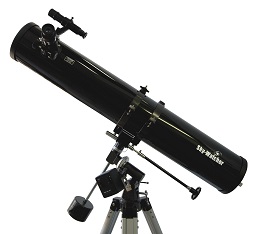|
Intro
Looking for a Beginner's Telescope? Let us help You!
Chapter 1
Why Do You Need A Telescopes
Chapter 2
Types of Telescopes
Chapter 3
Now you need to mount your scope!
Chapter 4
Accessorise, Accesorise (with eyepieces and filters)
Chapter 5
Enroute to Astrophotography
Chapter 6
Caring and Collimating your Telescope
Chapter 7
Solar Observations and a How-To guide on making a solar filter
|

Buying your first telescope is a big step, especially for a beginner. If you have been browsing around the telescope markets, chances are, you must have come across terms such as Newtonian Reflector, Maksutov Cassegrain, Schmidt Cassegrain, and many more! So, what do they mean? Are they really that different from each other? What should a beginner go for? If you have any of these questions running through your mind, then stick around.
Types of Telescopes
Telescopes have been around since the 1600s, and since then, they have been through a lot of design changes. These design changes are more than just aesthetic improvements, each design brings something new to the table while refining the manufacturing process. Nowadays, all telescopes fall within three major types, which are: Refractors, Reflectors, and Catadioptric telescopes. Within those three types are many different hybrid designs and variations. Let’s start with the Refractor telescope.
REFRACTOR TELESCOPE
A refractor telescope has a long tube with a large objective lens at the front and an eyepiece at the back. Light passes through the curved objective lens along a single path where it converges at the back of the telescope tube. An eyepiece at the back of the telescope is used to flatten and focus the light at the exit pupil of the eyepiece to form a viewable image.
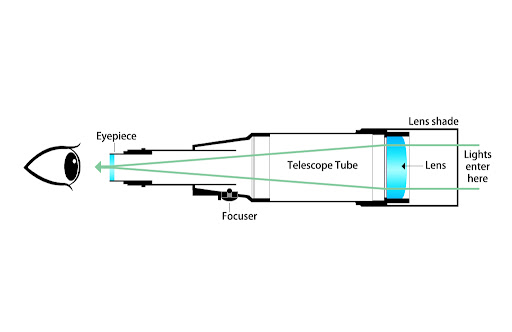
High-quality refractors tend to produce sharper and brighter-looking images with a wide field of view. Refractor telescopes are great for beginners since they require little to no maintenance compared to the other types of telescopes. Due to the absence of mirrors, they are generally less prone to misalignment compared to reflector telescopes.
The drawbacks to refractor telescopes are the higher cost of producing a high transmission glass lens, and chromatic aberration/colour fringing along the edges of objects. Chromatic aberration occurs when different wavelengths of light travel at different speeds as they pass through the curved lens of the telescope. To counter this issue, some refractors will utilize special sets of lenses to adjust the different wavelengths into a more focused image.
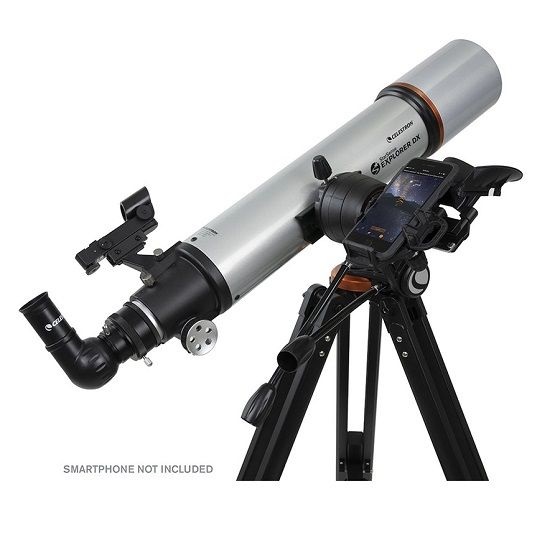
Celestron StarSense Explorer DX 102AZ Refractor Telescope
Refractors also tend to have longer tubes, because of this, they require a heavy and tall tripod to reach the eyepiece located at the back. If you are planning to move around with your telescope, this is something you should really consider.
REFLECTOR TELESCOPE
Reflectors are much more cost-effective than refractors, eliminating the need for a large glass lens. Light traveling down the telescope tube is reflected by a large primary mirror onto a secondary mirror near the front of the telescope. The light is then directed through an eyepiece on the side of the telescope tube. One of the most common forms of reflectors is the Newtonian reflector. As explained previously, reflectors mainly use mirrors which are easier to manufacture compared to glass lenses used in refractor telescopes. Because of this, they are known to be the most efficient design compared to the other types of telescopes with the same aperture size.
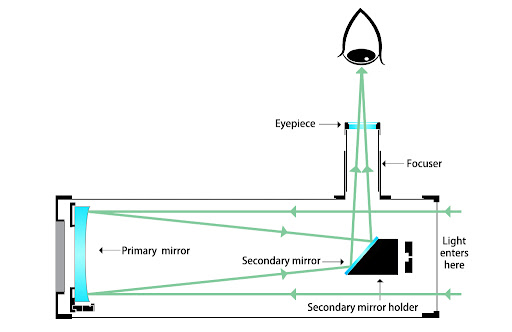
Another famous variant of the Newtonian telescope is the Dobsonian telescope. This telescope is usable without a tripod and has a relatively short setup time. Dobsonian reflectors are the most cost-effective type of telescope and perfect for those looking for their first telescope to venture into astronomy without breaking the bank.
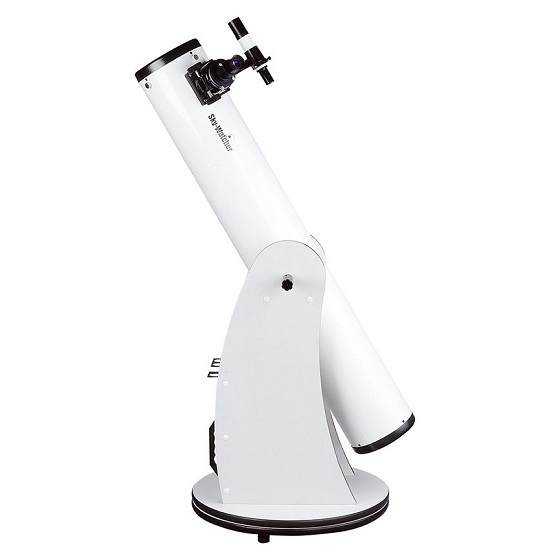
SkyWatcher 6" Dobsonian Telescope
Although they are relatively cheaper compared to the other types of telescopes, the reflectors require slightly more maintenance to perform well. Due to the more open design, dust and debris may get into the tube, and, as the mirrors are usually held in place by clamps; they may become misaligned by impact or constant vibrations. To correct the alignment of the mirrors, the telescope will need to go through a process called collimation. However, you should not worry since there are tools such as the laser collimator to help make collimation easier.
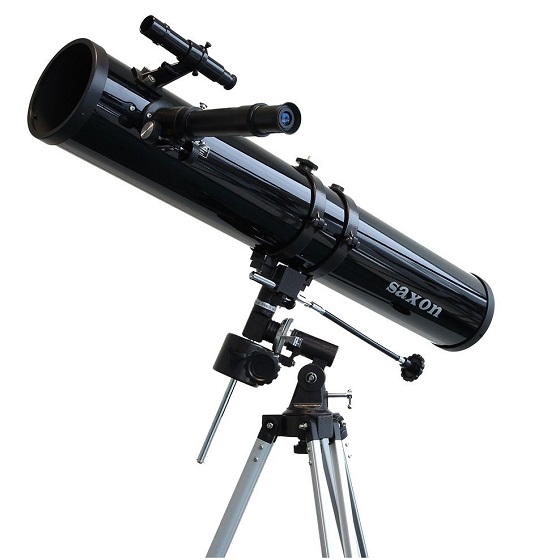
Saxon 114/900 EQ Newtonian Reflector Telescope
CATADIOPTRIC/CASSEGRAIN TELESCOPE
The last type of telescope is the catadioptric or compound telescope which is a combination of both the refractor and reflector telescopes since they utilize both lenses and mirrors to work. They tend to be more compact and lightweight in design, requiring less hefty tripods and mounts, making them very easy to transport. Some of the more famous variations of the catadioptric telescope are the Maksutov-Cassegrain and Schmidt-Cassegrain.
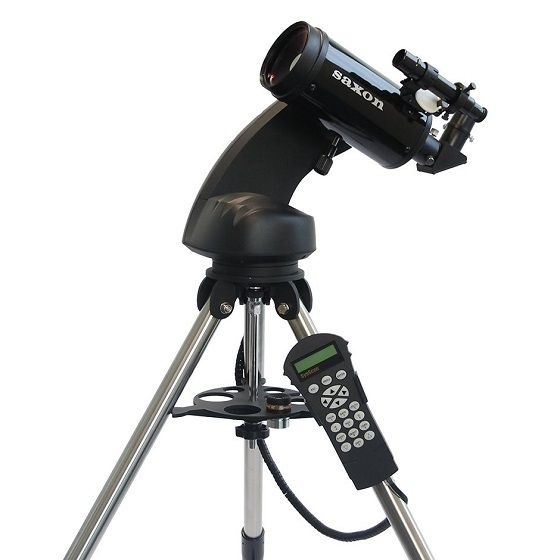
Saxon AstroSeeker 90/1250 Maksutov-Cassegrain Telescope (WiFi Enabled with Hand Controller)
The main characteristic of a Maksutov-Cassegrain is the curved spherical lens used for correcting coma and chromatic aberration. This lens is usually thick and costly to manufacture. On the other hand, the primary mirror is also spherical and cheaper to manufacture than a parabolic mirror. The secondary mirror is convex but larger compared to the ones in Schmidt-Cassegrain scopes, resulting in a larger central obstruction as the size of the primary mirror increases, as well as lengthy cool-down times for the secondary mirror. Because of this design, MAKs are generally not manufactured larger than 7 inches. Since they generally have a higher focal ratio with a longer focal length, they are a good choice for planetary observations but not for faint deep sky objects.
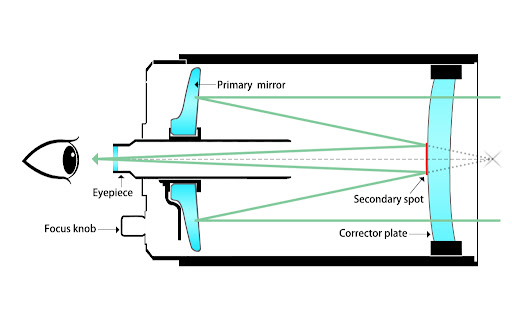
For Schmidt-Cassegrain, the corrector plate used is an aspheric lens and spherical aberration is corrected ahead of the primary spherical mirror. Because of this, SCTs generally have bigger apertures compared to MAKs which leads to shorter cool-down times and produces cleaner images. Like the reflectors, the Schmidt-Cassegrain telescopes will occasionally have to undergo collimation for realignment. Unlike reflectors, the interior of the tube is better protected against dust and dirt. It’s still a good idea to leave the dust cover on to protect the exposed objective lens when not in use.
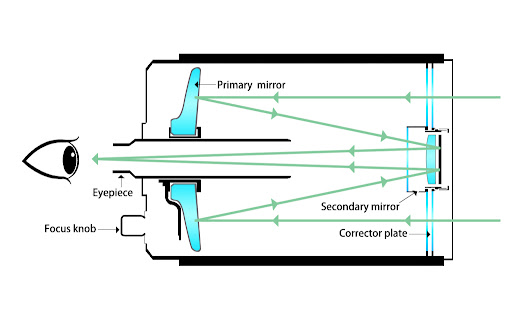
Summary
Now that you understand the basic types of telescopes available, here are the summaries of the advantages and disadvantages of each type of telescope with links to some models available for purchase in our store!
| Land & Sky |
Planetary |
Deep Sky |
All Rounder |
| Resolution & Portability |
Easy |
Intermediate |
Advanced |
| Higher Resolution |
16" 406/1800 f/4.4 Colapsible Dobsonian |
16" 406/1800 f/4.4 Colapsible GoTo Dobsonian |
20" 508/2000 f/4 Colapsible GoTo Dobsonian |
| |
16" 406/1800 f/4.4 Colapsible Dobsonian |
14" 355/1650 f/4.6 Colapsible Goto Dobsonian |
14" 356/3910 f/11 GoTo EQ Schmidt-Cassegrain |
| |
12" 305/1500 f/5 Dobsonian |
12" 305/1500 f/5 Colapsible GoTo Dobsonian |
300/1500 f/5 GoTo EQ Reflector |
| |
12" 305/1500 f/5 Colapsible Dobsonian |
10' 254/1200 f/4.7 Colapsible GoTo Dobsonian |
300/1200 f/4 GoTo EQ Reflector |
| |
10" 254/1200 f/4.7 Dobsonian |
8" 203/1200 f/6 Colapsible GoTo Dobsonian |
11" 280/2800 f/10 GoTo AZEQ Schmidt-Cassegrain |
| |
10' 254/1200 f/4.7 Colapsible Dobsonian |
200/1000 f/5 EQ Reflector |
11" 280/2800 f/10 GoTo EQ Schmidt-Cassegrain |
| |
8" 203/1200 f/6 Dobsonian |
150/750 f/5 EQ Reflector |
250/1200 f/4.8 GoTo EQ Reflector |
| |
8" 203/1200 f/6 Colapsible Dobsonian |
150/750 f/5 GoTo AZ Reflector |
250/1000 f/4 GoTo EQ Reflector |
| |
6" 150/1200 f/8 Dobsonian |
6" 150/750 f/5 Colapsible GoTo Dobsonian |
9.25" 235/2350 f/10 GoTo AZEQ Schmidt-Cassegrain |
| |
6" 150/750 f/5 Colapsible Dobsonian |
130/900 f/7 EQ Reflector |
9.25" 235/2350 f/10 GoTo EQ Schmidt-Cassegrain |
| |
6" 150/1500 f/10 AZ Schmidt-Cassegrain |
130/650 f/5 EQ Reflector |
200/1000 f/5 GoTo EQ Reflector |
| |
5" 130/650 f/5 Colapsible Dobsonian |
130/650 f/5 GoTo AZ Reflector |
200/800 f/4 GoTo EQ Reflector |
| |
5" 127/1250 f/10 AZ Schmidt-Cassegrain |
5" 130/650 f/5 GoTo Dobsonian |
8" 203/2032 f/10 GoTo AZEQ Schmidt-Cassegrain |
| |
127/1000(500) f/8 AZ Reflector |
5" 130/650 f/5 Colapsible GoTo Dobsonian |
8" 203/2032 f/10 GoTo EQ Schmidt-Cassegrain |
| |
120/600 f/5 AZ Refractor |
127/1500 f/12 GoTo AZ Mak-Cassegrain |
190/1000 f/5 GoTo EQ Mak-Newtonian Reflector |
| |
114/500 f/4.4 AZ Reflector |
127/1500 f/12 GoTo Mak-Dobsonian |
180/2700 f/15 GoTo EQ Mak-Cassegrain |
| |
102/660 f/6.5 AZ Refractor |
114/900 f/8 EQ Reflector |
150/1800 f/12 GoTo EQ Mak-Cassegrain |
| |
90/900 f/10 AZ Refractor |
114/1000(500) f/9 EQ Reflector |
6" 150/1500 f/10 GoTo AZEQ Schmidt-Cassegrain |
| |
80/900 f/11 AZ Refractor |
102/1000 f/10 EQ Refractor |
5" 125/1250 f/10 GoTo AZEQ Schmidt-Cassegrain |
| |
80/800 f/10 AZ Refractor |
102/1300 f/13 GoTo Mak-Cassegrain |
127/952 f/7.5 GoTo EQ Refractor |
| |
80/400 f/5 AZ Refractor |
100/900 f/9 EQ Refractor |
120/900 f/7.5 GoTo EQ Refractor |
| |
76/700 f/9 AZ Reflector |
90/900 f/10 EQ Refractor |
102/1000 f/10 GoTo EQ Refractor |
| |
76/300 f/4 Mini Dobsonian |
90/900 f/10 GoTo AZ Refractor |
102/714 f/7 GoTo EQ Refractor |
| |
70/900 f/13 AZ Refractor |
90/1250 f/14 EQ Mak-Cassegrain |
100/900 f/9 GoTo EQ Refractor |
| |
70/700 f/10 AZ Refractor |
90/1250 f/14 GoTo AZ Mak-Cassegrain |
80/600 f/7.5 GoTo EQ Refractor |
| |
70/500 f/7 AZ Refractor |
90/1250 f/14 GoTo Mak-Dobsonian |
|
| |
70/400 f/6 AZ Travel Refractor |
70/900 f/13 EQ Refractor |
|
| |
60/700 f/12 AZ Refractor |
|
|
| More Portable |
50/600 f/12 AZ Refractor |
|
|
The advances made in telescope manufacturing technology have made astronomy more accessible to the public. There has never been a better time than now to kickstart your astronomy journey with various brands offering competitive prices and advanced models, equipped with state-of-the-art technologies. Just remember to get your telescopes from reputable dealers. Or better yet, just buy from us for your telescope needs!
|












